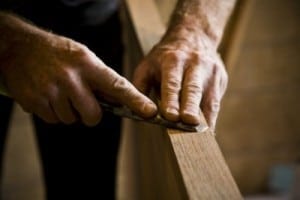Bob's Bloggers
A community of bloggers who live and die to DIY
paint, preservation
The Cost of Doing it Right: Painting Your Historic Home
By The Craftsman on Jul 01, 2013
I get crazy looks from clients when I tell them the price for some of our services. I’m not oblivious to the fact that historic preservation is sometimes expensive, but it seems that the cost of doing it right offends too many people today.

“Why would I spend $600 to have you restore my old window when I could buy a new one for $160 at Home Depot?”
I’ve heard versions of that statement so many times. Honestly, it’s hard for me to hear. I feel like I might be taking advantage of my clients, but deep down, I do know differently.
I know I am providing value. I know that in today’s culture of faster and cheaper products, a business that refuses to take shortcuts will survive on the few people who understand what quality really is.
That statement above would be similar to this in a car salesman’s world:
“Why would I spend $200,000 for a Rolls-Royce when I could buy a Ford Fiesta for $11,000?”
The answer seems clear in this scenario, doesn’t it?
I’m not saying that my window restorations or other services are the Rolls-Royce of the industry, but our work is detailed, precise and done by hand much like how Rolls-Royces are built. This quality of work results in a long-lasting, custom tailored product that is designed to work as an important part of your house.
Whereas the replacement window industry has a one-size fits all methodology to old houses.
The Tale of the Two Painters
Two painters bid on painting the exterior of an old house. The first, tells the homeowner that he can have it done in about four days and will charge $3,000. The painter quotes to spray a fresh coat of paint on the exterior and be out of their way relatively quickly with minimal disturbance to their lives.
“What a deal!” the homeowners think. To be wise they decide to get a second bid so they have something to compare it to.
The second painter comes by and offers a bid for $15,000 with the work taking approximately three weeks. His quote includes removing all the old paint and starting from scratch with primer and 2 coats of paint brushed on.
“Wow! 3 weeks is long time and that’s five times to cost of the first painter.”
Which one would you choose?
The Real Cost
Anyone can paint a house and make it last for three years. A decent painter can make that same paint job last for twice that long. And a master painter can apply a paint job that lasts for 15-20 years. Which one do you think costs more?
One 15-year paint job may cost upwards of $12,000-15,000, whereas the handyman with a paint brush will only charge you $3,000 for his work. You’ll have to redo that 3-year paint job five times over the next 15 years, but it’s affordable (in the short run) so who cares, right?
Even if the first painter doesn’t raise his prices one cent in 15 years you’ll still pay $15,000 over that course of time to keep your house painted. Not to mention the inconvenience of having a painter at your house every few years for a week or so, with your house accumulating an extra five coats of paint in that time. As a side note, research has shown that with each successive coat paint failure occurs sooner than the last.
Going back to our window example:
Hand painting window sashes is expensive. It is labor intensive. It requires a skilled painter. So, why do we do it? Because it is right. Hand painting is the only way to ensure a good seal and protect the window from the elements. If you want it done right, there is a price to pay.
Tape doesn’t work, plastic masking doesn’t work, liquid mask doesn’t work, only hand painting. Hundreds of people have spent millions of dollars and thousands of hours trying to find a more “cost-effective” way to accomplish this, but after all this time there hasn’t been one found.
There is a right way and a cheap way. While it may seem like a way to save money, in the short run, the cheap way is hardly ever the right way.
The cost of doing it right is expensive. Quality craftsmanship is expensive.
In the end, it’s up to you whether you want to pay once to have it done the right way, or pay the same amount over several times to have it done the cheap way. With the cheap way, the savings aren’t what they may first appear.
Image credit: keithbrofsky / 123RF Stock Photo